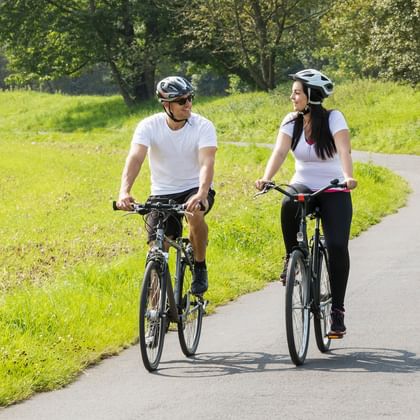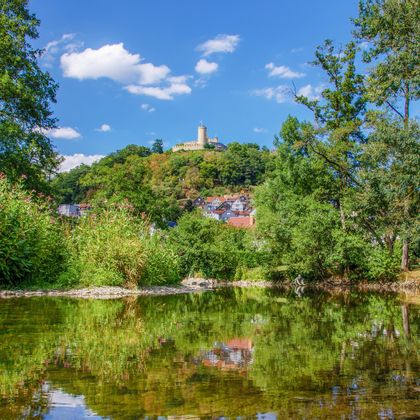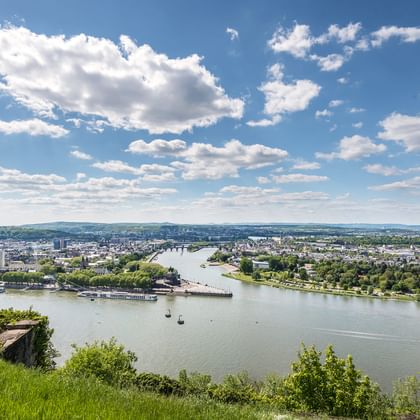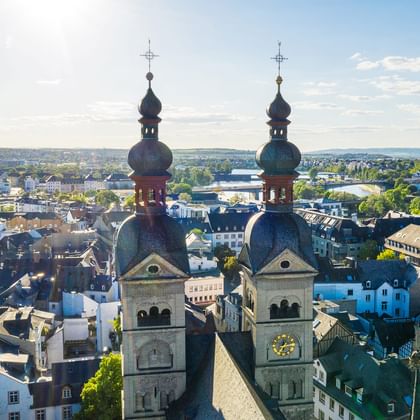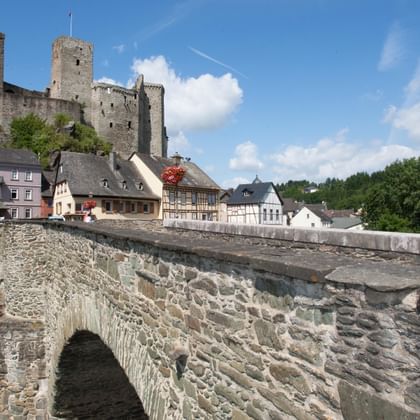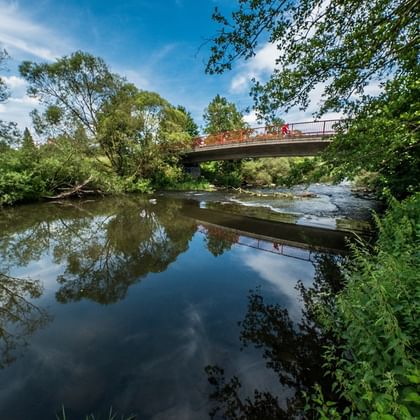Tour
The Lahnquelle is located in the middle of Germany in the beautiful Rothaargebirge mountains. You will spend the night directly at the source of the Lahn in the middle of the forest in the rustic, comfortable “Forsthaus Lahnquelle”.
Time flies on your first day of cycling. Starting at the spring you will cycle through beautiful wooded countryside to Bad Laasphe. Follow the young river to Biedenkopf an the old town of Marburg. Culture and history have always aroused each other in Marburg. The famous Elisabeth church and the landgraves' palace are worth visiting. In the evening you can enjoy your time in international restaurants or students pubs.
Today you cycle through the wide Lahn floodplains via Gießen first to the cathedral city of Wetzlar. Make sure you plan a visit to the old town - it's worth it! But the visit to the ore mine Fortuna (+ approx. 6 km) and the view from the fairytale castle Braunfels are definitely worth seeing as well.
Another highlight awaits you today. You cycle on the Lahn cycle path to Weilburg, whose renaissance castle you should definitely not miss! Follow the Lahn cycle path very close to the river. Visit what is probably Germany's largest castle ruin in Runkel, before visiting the world-famous Limburg cathedral and the beautiful old town.
Once again, the Lahn cycle path offers the highest level of cycling pleasure. You cycle on the former towpath to Balduinstein. On this section you can enjoy a bike path like in a picture book! A stop at the Lahn winegrowers will refresh the mind and the palate. Visit Nassau castle and the attractive, traditional Spa-town Bad Ems before the Rhine valley opens up before your eyes. In Lahnstein it is time to say goodbye to the idyllic course of the river Lahn, because the last few kilometers you follow the Rhine cycle path to the center of Koblenz.
Your holiday ends after breakfast. If you would like to return to the source of the Lahn, we recommend our practical return transfer service (departure 9am, which will take you directly from your hotel in Koblenz back to your starting hotel.
Map
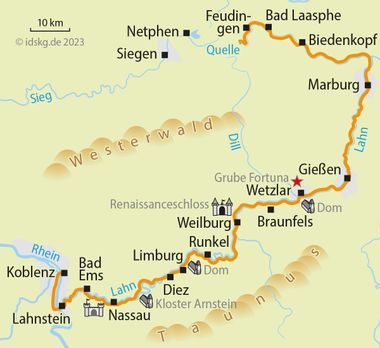
Prices / Dates
Services / Info
- Accommodation incl. breakfast:
Category A: Comfortable middle-class hotels, mostly in the center
Category B: partly family-run inns and smaller hotels, up to 5 km from the center - Room with shower/bath/WC
- Luggage transport
- Map of bike trails with marked route (2025)
- Digital route guidance via smartphone app
- Tips for tour preparation
- Touristic information
- 7 days hotline service
Worth knowing about the bike tour Lahn: sportive from the spring
Below you will find specific and helpful information. If you have further questions about this trip, you simply call us: Phone: +49 (0)6421 – 886890.
Arrival by train
The nearest train station is Feudingen. A transfer from Feudingen train station to the Hotel an der Lahnquelle can be booked through the hotel at a reasonable price. The cost per trip (maximum 6 people) is approx. 30.00€ (as of 2023), payable on site (closed on Tuesdays). You can find current timetable information and prices at: www.bahn.de
Parking facilities at the arrival location
At the Hotel Forsthaus Lahnquelle you can leave your car safely parked for the entire duration of your trip for a fee. The cost per parking space is approx. 5.00€ per day. Advance reservation is not necessary.
You will receive detailed information about the parking facilities at the hotel you have booked with the detailed travel documents two weeks before the start of your trip.
Condition of cycle paths
The Lahn cycle path leads through charming and varied landscapes with forests, hills, meadows, floodplains and steep slopes dotted with rocks. In 2006, the Lahn Valley Cycle Path was one of the first cycle paths in Germany to be awarded 4 out of 5 possible stars by the ADFC. Among other things, it was assessed for its navigability, signposting, safety and tourist infrastructure.
You cycle on mostly flat, asphalted cycle and hiking paths away from traffic, with only the occasional small climb to contend with. The route is well and uniformly signposted throughout. For the most part, a railroad line runs parallel to the cycle path.
Current information on the route can be found on the website of the Lahntal Tourismus Verband e.V.: Current tips and information
Transfer back to the starting point of the journey
Daily at 9am there is the possibility to use our transfer service back to Marburg (approx. 2 hrs). Pick up is at your hotel and the bus takes you back to your first hotel, thus ensuring a perfect return service. If you bring your own bicycles, an additional fee will be charged.
Extra costs which are not included in the tour price
A possible tourist tax and charging fees for bicycle batteries are also not included in the tour price and must therefore be paid at the hotel on site.
7 days hotline service
Just in case the bike chain breaks, flooding makes it impossible to continue your tour or any other nasty surprise: You can reach us seven days a week and we will do anything to help you as fast as possible.
Passport and visa requirements
For EU citizens, there are no special passport or visa requirements and no health formalities to be considered for this trip.
Travel insurance
The tour price already includes the statutory insolvency insurance. In addition, we recommend that you take out travel cancellation insurance upon receipt of your travel confirmation in order to protect yourself against financial disadvantages in the event of travel cancellation, interruption of travel, illness or accident.
For this trip, we recommend using digital travel documents in the interest of sustainability. However, if you prefer, you can choose printed travel documents with a cycling map during the booking process. Please note that price differences may apply depending on your selection.
Available rental bikes
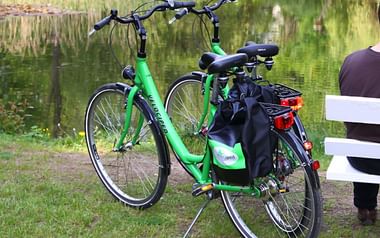
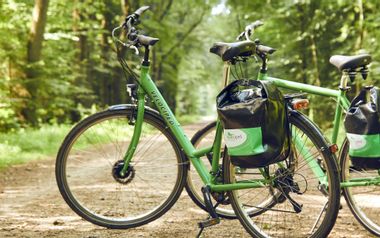
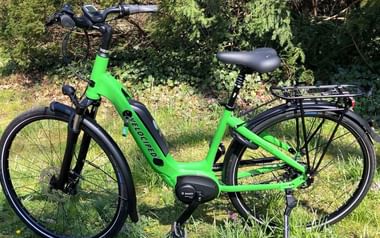


We would recommend the 7-speed tourer for all those that are looking for a back-pedal brake and wide gel seat for maximum comfort in an upright sitting position. It is equipped with a simple hub gear shift and is perfectly suited to tours on flat to slightly hilly terrain.

The 27-speed tourer is the best choice for cyclists that value the advantages of the dérailleur gear shift for flexibility whilst going up and down hills. This bike allows you to be a little more active without compromising on saddle comfort and practical everyday suitability.

E-bikes combine a lot of advantages. The electric drive ensures a completely relaxed cycling, even during long tours or on hilly routes. Other features, such as a suspension seat post and front fork plus well-tuned gears, ensure additional riding comfort.

On this trip, you can choose between e-bikes with a back-pedal brake or a freewheel. The e-bikes with a freewheel also offer you excellent riding comfort with a suspension seat post and front fork. Please simply indicate your preference when booking.
Available rental bikes





We would recommend the 7-speed tourer for all those that are looking for a back-pedal brake and wide gel seat for maximum comfort in an upright sitting position. It is equipped with a simple hub gear shift and is perfectly suited to tours on flat to slightly hilly terrain.

The 27-speed tourer is the best choice for cyclists that value the advantages of the dérailleur gear shift for flexibility whilst going up and down hills. This bike allows you to be a little more active without compromising on saddle comfort and practical everyday suitability.

E-bikes combine a lot of advantages. The electric drive ensures a completely relaxed cycling, even during long tours or on hilly routes. Other features, such as a suspension seat post and front fork plus well-tuned gears, ensure additional riding comfort.

On this trip, you can choose between e-bikes with a back-pedal brake or a freewheel. The e-bikes with a freewheel also offer you excellent riding comfort with a suspension seat post and front fork. Please simply indicate your preference when booking.
